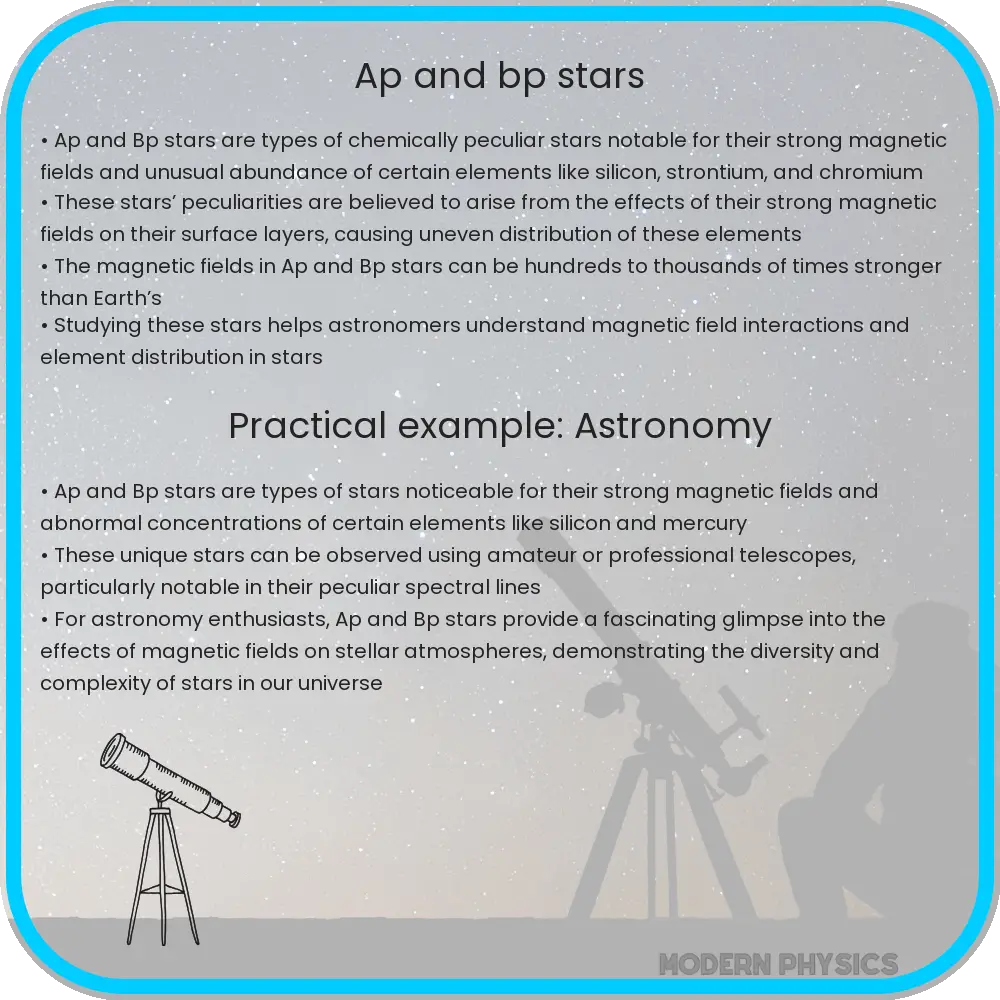Explore the mysteries of Ap and Bp stars, their strong magnetic fields, peculiar chemical compositions, and impact on stellar evolution in this detailed analysis.

Introduction to Ap and Bp Stars
Ap and Bp stars represent unique classes of stars known for their strong magnetic fields and peculiar chemical compositions. These stars are typically classified within the spectral types A and B, where ‘p’ denotes their peculiarity. The peculiarities observed in these stars are primarily related to overabundances or underabundances of certain chemical elements such as silicon, mercury, or iron when compared to other stars of similar types.
Magnetism in Ap and Bp Stars
The magnetic fields of Ap and Bp stars are remarkably strong, often exceeding tens of thousands of Gauss (in contrast, the Earth’s magnetic field is about 0.5 Gauss). These intense magnetic fields are believed to be remnants of the magnetic field present during the star’s formation or generated through dynamo processes similar to those in the Sun but magnified due to their rapid rotation. The strong magnetic fields significantly influence the atmospheric structure and dynamics of these stars, leading to anisotropic winds and complex magnetic topologies.
Chemical Peculiarities
One of the defining features of Ap and Bp stars is their abnormal chemical compositions. These peculiarities are most likely caused by atomic diffusion – a process where radiation pressure and gravitational settling cause certain elements to rise to the star’s surface or sink into its interior. As a result, Ap and Bp stars exhibit strong absorption lines for certain elements. For example, Ap stars are known for their strong silicon (Si) lines, while Bp stars often show enhanced mercury (Hg) and manganese (Mn) lines. The chemical peculiarities can be so pronounced that they influence the star’s photometric and spectral characteristics, leading to the classification of subgroups such as Mercury-Manganese (HgMn) stars and Silicon (Si) stars.
Evolutionary Considerations
Understanding the evolution of Ap and Bp stars is complex due to their unique properties. The interaction between their magnetic fields and chemical peculiarities plays a crucial role in their evolution. These stars do not follow the typical evolutionary pathways of non-magnetic stars due to the significant impact of magnetic braking, which alters their angular momentum and can modify their evolutionary tracks on the Hertzsprung-Russell diagram.
Stellar Rotation and Magnetic Braking
The rotational velocities of Ap and Bp stars are another area of intense study. Unlike typical A or B stars, Ap and Bp stars often exhibit slower rotation rates. This phenomenon is attributed to magnetic braking, where the star’s magnetic field exerts a drag on the stellar winds, thereby reducing the star’s angular momentum over time. The decreased rotation rate has a direct impact on the diffusion processes responsible for the peculiar chemical surface patterns, further complicating their evolutionary trajectories.
Observational Challenges and Techniques
Studying Ap and Bp stars presents unique observational challenges due to their varying brightness and spectral features caused by their rotating magnetic fields. Techniques such as spectropolarimetry have been instrumental in dissecting the magnetic structures of these stars. Additionally, time-resolved spectroscopy allows astronomers to observe changes in spectral lines as the star rotates, providing insights into the spatial distribution of elements on the star’s surface and the configuration of its magnetic field.
Impact on Stellar and Galactic Astrophysics
The study of Ap and Bp stars has significant implications for both stellar and galactic astrophysics. Understanding these stars helps astronomers refine models of stellar evolution, particularly regarding the effects of magnetic fields on stellar structure and evolution. Furthermore, as these stars often exist in binary systems, they provide natural laboratories for studying the interactions between magnetic fields and binary dynamics. On a galactic scale, Ap and Bp stars contribute to our understanding of chemical enrichment processes and the magnetic history of the galaxy.
Conclusion
Ap and Bp stars are fascinating celestial objects that offer profound insights into the interplay between magnetism, rotation, and chemical composition in stellar environments. Their peculiarities challenge conventional models of stellar evolution and highlight the diversity of processes that can occur within stars. The ongoing study of these unique stars continues to push the boundaries of our understanding, illustrating the complexity and dynamism of the universe. As observational techniques advance and theoretical models refine, the mysteries of Ap and Bp stars will further unravel, contributing to the broader field of astrophysics and deepening our comprehension of the stellar life cycle.
